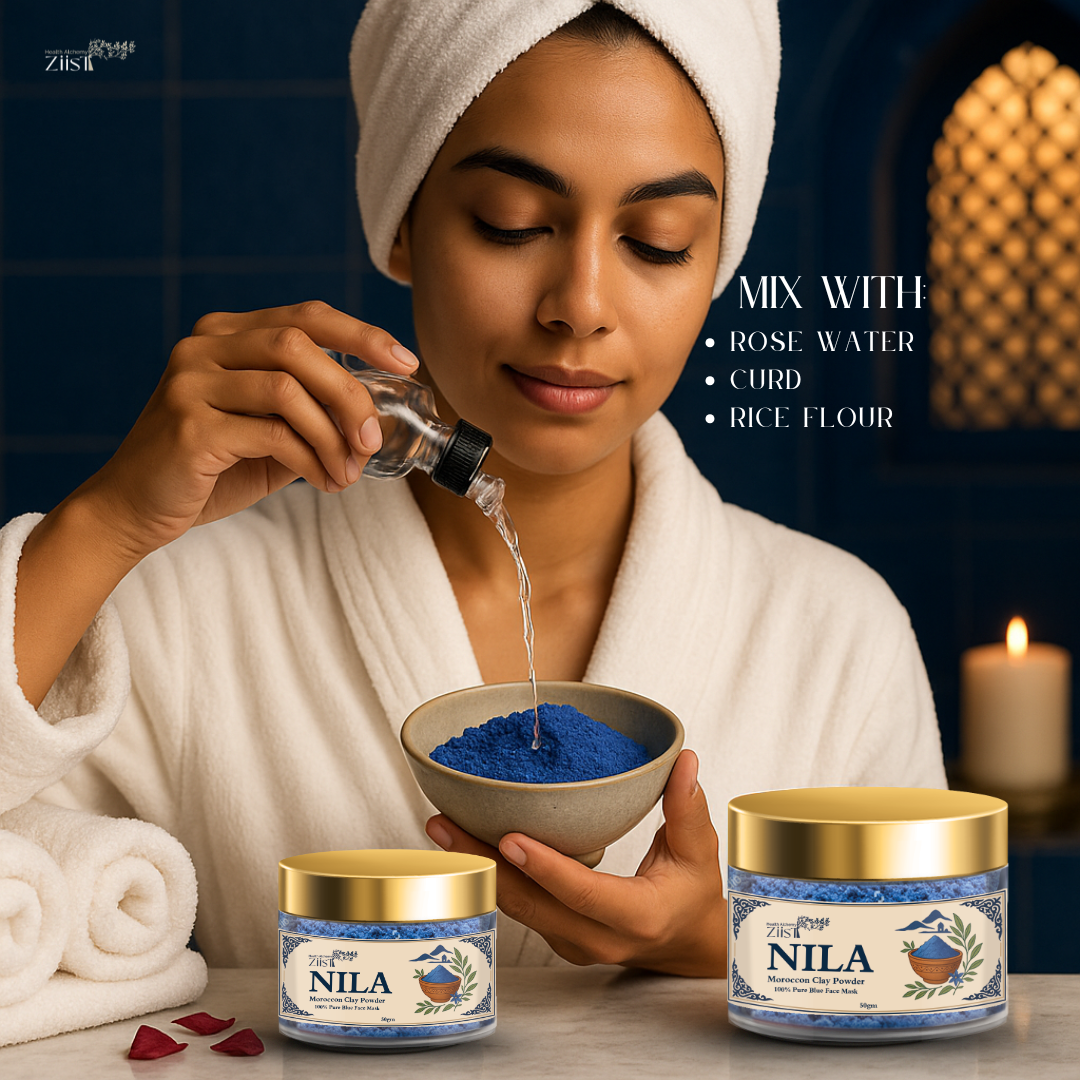The Science Behind Nila Moroccan Clay: How It Fights Dark Spots and Blemishes
Skin pigmentation and blemishes are among the most persistent skincare concerns today. Whether caused by acne scars, sun exposure, or hormonal changes, these dark spots can be difficult to treat without irritating the skin. This is where Nila Moroccan Clay stands out—a mineral-rich natural remedy with proven benefits for skin brightening, detoxification, and inflammation control. In this blog, we’ll explore the science behind Nila Moroccan Clay and how it works to fade pigmentation and reduce blemishes without harsh chemicals.
What Is Nila Moroccan Clay?

Nila Moroccan Clay, also known as Moroccan Blue Clay, is a rare and naturally pigmented clay sourced from the Atlas Mountains of Morocco. With a rich blue color and silky texture, it’s traditionally used by Berber women for its purifying and glow-enhancing properties. What makes this clay unique is its mineral content—especially silica, magnesium, and calcium—known for supporting healthy skin cell turnover and reducing melanin overproduction.
How Nila Moroccan Clay Works on the Skin

1. Reduces Melanin Production
Hyperpigmentation often results from excess melanin caused by sun exposure or inflammation. Nila Moroccan Clay contains minerals that help regulate melanin synthesis and reduce discoloration over time.
2. Promotes Gentle Exfoliation
Dead skin buildup can make dark spots appear more prominent. The clay’s fine texture allows for non-abrasive exfoliation, which helps reveal fresher, more even-toned skin without irritation.
3. Enhances Blood Circulation
Improved circulation boosts nutrient delivery and skin cell regeneration. The natural minerals in Nila Moroccan Clay stimulate microcirculation when applied, helping speed up the fading of marks and blemishes.
4. Fights Inflammation and Breakouts
Blemishes often leave behind red or brown post-inflammatory hyperpigmentation. Nila Clay calms inflammation while detoxifying pores, reducing the chance of future flare-ups and further scarring.
The Scientific Edge: Mineral Composition Breakdown
| Mineral | Benefit |
|---|---|
| Silica | Strengthens connective tissue and supports skin repair |
| Magnesium | Calms irritated skin and regulates oil production |
| Calcium | Promotes skin renewal and barrier function |
| Zinc (trace) | Antibacterial and helps fade scars |
Together, these minerals make Nila Moroccan Clay a naturally bioavailable solution for common skin concerns like pigmentation, acne, and post-blemish spots.
Best Way to Use Nila Moroccan Clay for Dark Spots

Targeted Face Mask Application
Step 1: Mix 1–2 teaspoons of Nila Moroccan Clay with rose water or aloe vera gel.
Step 2: Apply directly to pigmented areas or all over the face.
Step 3: Leave for 10–12 minutes.
Step 4: Rinse off with lukewarm water and pat dry. Follow with a vitamin C or niacinamide serum.
Use 2–3 times per week for visible improvements in skin tone and clarity.
Where to Find Pure, Unadulterated Nila Moroccan Clay
For best results, choose a clean formulation free from dyes or additives. We recommend the Ziist Nila Moroccan Blue Clay Powder — a premium, dermatologist-tested option safe for all skin types.
Want to Learn More About Its Benefits?
Explore how Moroccan Blue Clay helps oily and acne-prone skin in our related blog:
🔗 Why Moroccan Blue Clay Is a Game-Changer for Oily and Acne-Prone Skin
Tips for Even Better Results
- Always apply on clean skin for maximum absorption
- Mix with a few drops of licorice extract for added brightening effect
- Avoid direct sunlight immediately after masking—apply SPF
- Be consistent—visible fading takes 4–6 weeks of regular use
FAQs About Nila Moroccan Clay and Pigmentation
Can Nila Clay completely remove pigmentation?
It significantly lightens pigmentation and evens out skin tone with regular use, but deep melasma may require additional dermatological support.
Is it safe to use during acne breakouts?
Yes, it’s ideal during breakouts due to its anti-inflammatory and antibacterial effects.
How long does it take to see results?
Typically 4–6 weeks with 2–3 applications per week.
Can it be mixed with other actives like Vitamin C?
Yes, but apply actives separately. Use the clay first, then apply serum after rinsing and drying the skin.
Why You Should Add Nila Moroccan Clay to Your Skincare Ritual
With its unique mineral composition and gentle yet powerful skin-clearing benefits, Nila Moroccan Clay is a standout choice for anyone dealing with dark spots, blemishes, and acne-related pigmentation. Whether used alone or as part of a full skincare routine, it helps promote even tone, clarity, and radiance without compromising your skin barrier.

